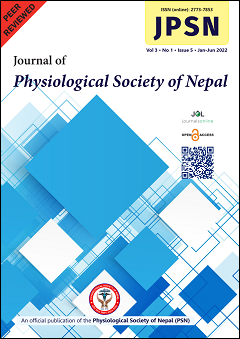Association of obesity markers and peak expiratory flow rate in healthy students of a medical campus of Kathmandu, Nepal
DOI:
https://doi.org/10.3126/jpsn.v3i1.57763Keywords:
Body fat percentage, Peak expiratory flow rate, Waist circumference, Waist hip ratioAbstract
Background: Obesity is a major health problem worldwide in the developed as well as in developing countries like Nepal. It has been linked with different co-morbidities that are known to increase the incidence of cardiopulmonary problems. The study aims to find the association of obesity markers with peak expiratory flow rate in young healthy participants.
Methods: A cross-sectional analytical study was performed in 114 students of Maharajgunj Medical Campus in between the age group of 18-25 years. Subject’s body mass index, waist circumference, waist hip ratio, body fat percentage and peak expiratory flow rate were assessed. Peak expiratory flow rate was correlated separately with obesity markers using Pearson’s correlation test.
Results: The mean peak expiratory flow rates for male and female were 524.18±87.30 L/min and 355.78±77.89 L/min respectively. A negative correlation was found between peak expiratory flow rate and body mass index (r=-0.082, p=0.50), and also with waist circumference (r=-0.148, p=0.21), waist hip ratio (r=-0.095, p=0.42) and body fat percentage (r=-0.061, p=0.61) in males. In females, peak expiratory flow rate had a negative correlation with body mass index (r=-0.237, p=0.13) and body fat percentage (r=-0.227, p=0.15) whereas, it had a positive correlation with waist circumference (r=0.031, p=0.84) and waist hip ratio (r=0.023, p=0.89).
Conclusion: All the obesity markers were negatively correlated with peak expiratory flow rate in males, whereas body mass index and body fat percentage were negatively correlated but waist circumference and waist hip ratio were positively correlated with peak expiratory flow rate in females. PEFR may not be affected by obesity both in males and females as all the correlations are weak.
Downloads
Downloads
Published
How to Cite
Issue
Section
License
Copyright (c) 2023 Journal of Physiological Society of Nepal

This work is licensed under a Creative Commons Attribution-NonCommercial 4.0 International License.

